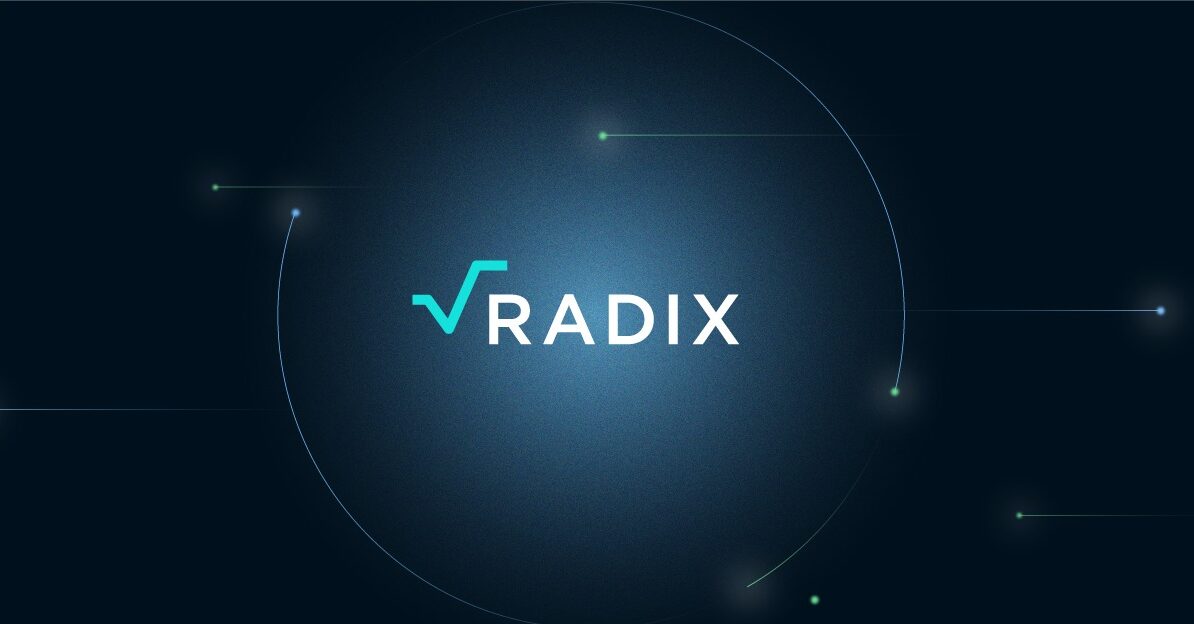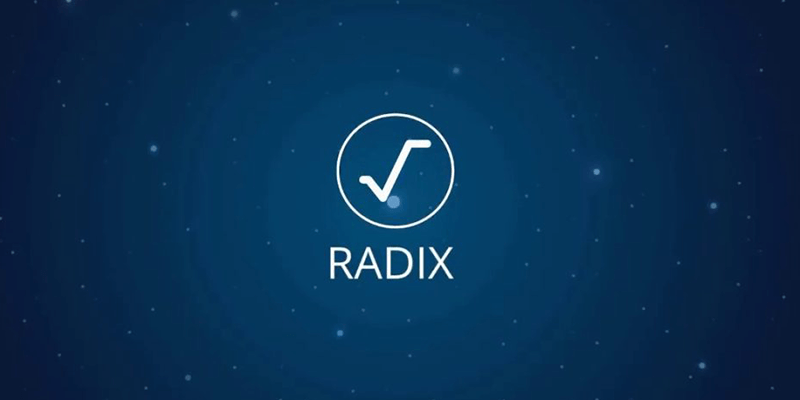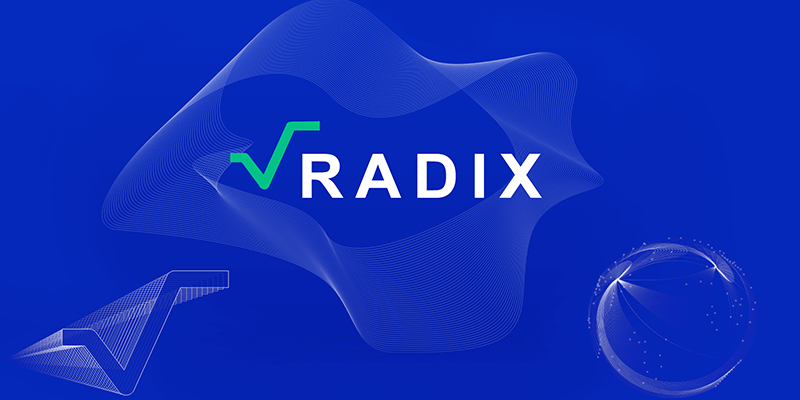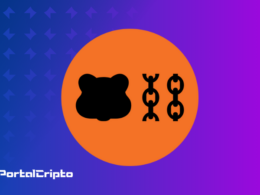Radix DLT (Distributed Ledger Technology) is a full-stack Layer 1 protocol that makes it easy for developers to build and scale decentralized finance (DeFi) applications without the risk of network congestion, smart contract hacks, and exploits. Radix Engine is a scalable and secure runtime environment that doesn't compromise on composability. The Radix DeFi platform offers several alternatives to Layer 1 protocols that are not suitable for large-scale DeFi adoption. The introduction of the Radix (XRD) token comes in line with the launch of Olympia Mainnet. This marks the introduction of the ERC-20 e-Radix token (eXRD token), along with the fundamental technologies that will form the basis of all protocol updates.
In this article, we will discuss:
What is Radix DLT?
Radix DLT (Distributed Ledger Technology) is an integrated technology solution that addresses common issues that create barriers to decentralized finance (DeFi). Furthermore, Radix claims that it is “the only decentralized network where developers will be able to build quickly without the constant threat of exploits and hacks”. As a layer 1 protocol, Radix optimizes synchronicity between fragments, allowing for scalability of multiple chains without compromising composability or security. Additionally, the Radix developer community receives rewards for any improvements made to the protocol using the native XRD token.
Radix addresses four key issues developers face when building distributed ledger technology (DLT) and decentralized finance (DeFi) applications. To achieve mass adoption, builders of decentralized applications (dApps) must be able to:
- Minimize smart contract exploits.
- Build interoperable apps faster.
- Provide incentives to foster a decentralized community of developers.
- Scale applications without reducing compositing.
Approaching each layer of the DeFi stack one by one, Radix is creating a platform that allows DeFi innovation to thrive, providing developers with an environment created specifically to build next-generation smart contracts with confidence, while minimizing the risk of hacks, code, and exploits.
Starting from scratch, Radix uses the Cerberus consensus protocol based on Byzantine Fault Tolerance (BFT) to allow DeFi to scale without obstructing compositing.
Composability – DeFi Lego Bricks
Generally speaking, in decentralized finance (DeFi), the term “composability” refers to the resources used to build platforms and their ability to be reused. A term that has become synonymous with this is “Lego DeFi bricks”. This means that the features within a DeFi protocol are modular and can work in conjunction with existing applications or to create new protocols and applications. Furthermore, the compositing capability allows apps to interact with each other just like Lego DeFi bricks, and is essential for developers to build apps quickly.
Instead of writing each line of code from scratch, various open source elements can serve as building blocks for creating new DeFi applications. For example, many open source templates are available on OpenZeppelin. This includes the ERC-20, ERC-721, and ERC-1155 token standards, as well as templates for decentralized exchanges, marketplaces, and research applications.
Cerberus consensus
Cerberus is the consensus protocol that Radix uses. Named after the three-headed dog in Greek mythology, the Cerberus consensus protocol takes an innovative approach to decentralized DLT consensus using a paralleled BFT (Byzantine Fault Tolerance) consensus process. Using Cerberus, all transactions are atomically composed into multiple shards.
This is a crucial element for scalability if DeFi is to achieve mass adoption and serve billions of users. Also, as the number of nodes in the entire network increases, the throughput of the network also increases. This is due to the Radix Engine application layer.
Radix engine
Radix Engine is a development environment that minimizes the risk of smart contract hacks and exploits. Additionally, the Radix Engine serves as a decentralized “self-incentive developer ecosystem” to foster the growth of a community based on Radix developer tools.
Designed specifically for “the creation of logic that defines predictable and correct results in the ledger in response to requests”, the Radix Engine derives its programming from the Finite State Machines (FSMs) used in mission-critical systems that demand predictable accuracy across all the moments. The smart contracts that the Radix engine creates are aptly called “Components”.
Two of the most innovative features of Radix Engine are the Component Catalog and the Developer Royalty System.
Radix developer royalty system
The Radix Developer Royalty System serves as an incentive for developers to deploy applications on Radix. Automated accounting system rewards developers for creating smart contracts for decentralized finance (DeFi) in Radix DLT. In turn, this has the potential to create an automated decentralized standalone marketplace for Radix Components.
Alternative
Radix uses a type of smart contract known as “Components”. The components behave more intuitively than Ethereum-based smart contracts, allowing for consistent and predictably reliable results. Additionally, Components act as DeFi Lego bricks that can be easily integrated into other applications.
The creation of Components is possible through a programming language known as Scrypto. Scrypto is a functional programming language that should be familiar to many DLT developers.
Before a Component becomes available to the network, it automatically enters the Component Catalog. The Component Catalog is an accounting record of dormant models or “Lego DeFi bricks” available for anyone to use as models or building blocks.
Components within the Component Catalog are enabled for use when a developer instantiates them from a Component model. Once active, these Instanced Components can be applied to an unlimited number of applications and will act the same way every time. This is particularly useful when creating multiple components with the same parameters. Also, getting instantiated is simplified using an application programming interface (API), no code required. So any developer can quickly and securely execute smart contracts or issue assets without having to learn the Scrypto programming language.
The Radix Token (XRD)
The Radix Token (XRD) is the native token of the Radix DLT network. The XRD token can be staked as part of the Radix Delegated Proof of Stake (DPoS) mechanism. Additionally, the XRD token is burned to pay network-wide transaction fees. XRD tokens are the only valid unit of exchange for transaction fees within the network.
With a maximum supply of 24 billion XRD tokens, Radix DLT holds 10% (2,4 billion) for future project development. In addition, another 10% allocation is for the future use of stablecoins on Radix. Just over 10% (2,79 billion) of the tokens go to the Radix Foundation, the non-profit arm of the Radix DeFi ecosystem. This is with the intention of supporting the Radix Ecosystem in the coming years. Additionally, 50% of the XRD token hard cap is for network issuance rewards, introducing 300 million XRD tokens into circulation each year. Furthermore, just under 15% of XRD tokens (4,41 billion) were initially allocated as e-Radix tokens, or eXRD tokens.
E-Radix tokens (eXRD token)
When Radix first launched the XRD token, it was deployed on Ethereum as an ERC-20 token. For a promising project with a mainnet still in development, deploying an early ERC-20 version of a project's token is becoming an increasingly common practice across the development space. blockchain. This allows projects to introduce their tokens to the largest smart contract-enabled blockchain, operable with most cryptocurrency wallets, exchanges and industry platforms. Token holders can then convert their ERC-20-based assets to the project's native token standard after the mainnet launch. However, Radix is operating a little differently.
After the launch of Olympia Mainnet (which we will discuss later), the XRD token became active on its native network. However, ERC-20-based XRD tokens remained on the Ethereum blockchain, becoming an encapsulated version of the XRD token, e-Radix, or eXRD token. eXRD token holders can exchange their tokens at a 1:1 ratio for the new, native XRD token. Both tokens have the same utilities and value. But, the original ERC-20, now eXRD token, is compatible across the entire Ethereum ecosystem. Furthermore, eXRD token holders can exchange their assets for XRD tokens seamlessly via Instabridge. Instabridge is an XRD token bridge created by Radix that connects the Ethereum and Radix ecosystems, facilitating 1:1 two-way token exchanges.
There is no expiration date for e-Radix token holders. Users can switch between XRD tokens and eXRD tokens at any time.
Why use Radix DeFi?
For decentralized finance (DeFi) to truly achieve mass adoption, applications must seamlessly facilitate interoperability. Developers must be able to communicate and build quickly without compromising security. Additionally, decentralized multi-chain applications (dApps) must be fast, secure, and resistant to exploits and hacks. In addition, developers must have access to the highest quality tools and string-independent programming languages to enable faster and more secure development of these next-generation DeFi applications.
Radix removes much of the friction that prevents seamless cross-chain interoperability between dApps and protocols on different blockchains. This creates an ideal environment for developers to build versatile cross-chain applications, allowing DeFi to reach its full potential. Additionally, Radix provides a secure environment with multiple tools for developers to build, test, and scale dApps without compromise.
By removing the barriers that limit the adoption and expansion of DeFi, Radix can meet the technological requirements for the future of traditional finance and decentralized finance (DeFi). Furthermore, the full-stack approach taken by Radix is reinventing distributed ledger technology (DLT), executable code in the book, consensus, application development, and developer incentives.
Olympia Mainnet
Olympia Mainnet is the initial version of the Radix Public Network. It lays the groundwork for the development of the Radix DeFi ecosystem and introduces the core Radix technologies upon which all future developments will be based. Additionally, Olympia marks the introduction of the native XRD token and three pieces of software.
- Radix Node is the software that operates on the Radix Public Network. Available for Windows, Mac and Linux, this software operates in one of three modes once installed. These are the validator node, full node, and file node.
- Radix Desktop Wallet is the premier wallet for storing, staking and trading XRD tokens. Using Radix Desktop Wallet, the Radix DeFi community can easily stake and stake XRD tokens.
- Radix Explorer is a tool that lists all registered validator nodes available for staking, including information about each validator that can help inform stakers which validator they want to bet on.
What is the Price Forecast for Radix Cryptocurrency (XRD)?
The price of Radix is predicted to reach a maximum level of $0.506 throughout 2022.
As early as 2023 according to our crypto price prediction index, Radix (XRD) may reach a maximum level of $0.975, with the average trading price of $0.725.
In 2025 according to our crypto price prediction index, XRD is expected to cross an average price level of $1.175. The minimum expected value of the Radix price at the end of the current year should be $1.085. Furthermore, XRD can reach a maximum price level of $1.198.
Where to Buy XRD Token?
XRD cryptocurrency can be traded on the following exchange:
- Bitfinex
Conclusion
Radix DLT is making decentralized finance (DeFi) scalable by providing a highly combinable, full-stack distributed ledger technology (DLT) solution that scales without compromise. Additionally, the native XRD token helps secure the network as well as being the only transaction fee exchange unit in the ecosystem. Furthermore, the Ethereum-encapsulated ERC-20 version of the token, e-Radix or eXRD token, is seamlessly operable with all decentralized finance (DeFi) applications in the Ethereum ecosystem.
Olympia Mainnet allows XRD to operate on its native network. In addition, Olympia Mainnet features Radix Explorer, Radix Desktop Wallet, and Radix Node. Radix Node is software that allows users to choose how they prefer to help secure the Radix Network. Furthermore, with the Radix Engine and highly versatile “DeFi Lego blocks”, Radix is changing the game for DeFi application developers.












